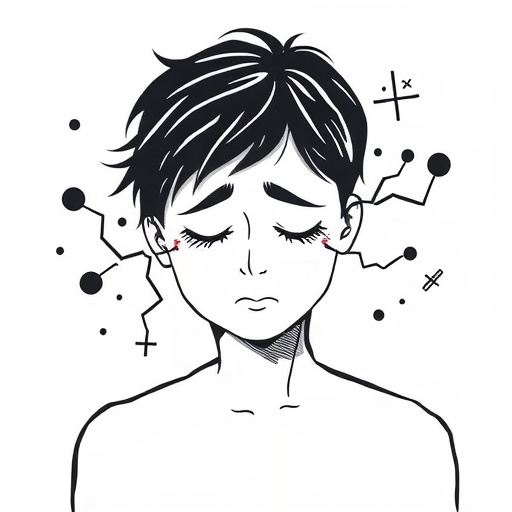In a groundbreaking study published in BMC Psychiatry, researchers have illuminated the intricate pathways that link anxiety symptoms to suicidal ideation (SI) among patients suffering from depression. The research, rooted in a dual-network analytical approach that combines computational psychiatry with clinical psychology, sheds light on how anxiety acts not merely as a co-occurring condition but as a central hub mediating the emergence of suicidal thoughts in these vulnerable populations.
Suicidal ideation, characterized by persistent thoughts about self-harm and death, remains a critical public health concern worldwide. While it is well-documented that depression fuels SI, the precise symptom dynamics within these patients have been less clear, especially considering the frequent comorbidity with anxiety disorders. This study’s contribution lies in its robust methodological design and the vast sample size, which provided a unique window into the symptom interplay that precipitates suicidal thinking.
The researchers analyzed clinical data from over 9,000 psychiatric outpatients, focusing in-depth on a subset of 281 individuals diagnosed with depression who completed standardized self-report measures: the Self-rating Depression Scale (SDS) and the Self-rating Anxiety Scale (SAS). Among these patients, approximately 30% reported active suicidal ideation, underscoring the urgent need to unravel symptom-based predictors that might inform early intervention strategies.
Employing a regularized partial correlation network permitted the team to quantify conditional associations between specific symptom dimensions of anxiety and depression, and SI. This approach moves beyond traditional binary assessments of comorbidity, providing nuanced insights into how certain symptoms dynamically interact rather than merely co-exist. Concurrently, a Bayesian network analysis mapped potential causal pathways, unearthing how anxiety and depressive symptoms might sequentially influence SI onset.
One of the most striking findings was the identification of “anxiety and panic” as a symptom dimension bearing the highest strength centrality within the network, signifying its pivotal role in SI development. The partial correlation network revealed direct associations between SI and two critical symptom clusters: “anxiety and panic” and “depressed mood.” Crucially, anxiety symptoms were not just co-occurring features but emerged as the central mediators linking depressive experiences to suicidal thinking.
The Bayesian network analysis further refined this understanding, presenting “anxiety and panic” as an indispensable mediator in all indirect pathways connecting depressive symptoms with SI. This suggests a sequential progression where depressive symptoms engender anxiety-related responses, which then catalyze or exacerbate suicidal ideation. Such a discovery challenges the conventional notion of treating depression and anxiety as parallel yet independent domains within psychiatric practice.
This research galvanizes the paradigm shift towards computational psychiatry—an interdisciplinary field marrying data science with mental health—which enables clinicians to visualize symptom networks instead of relying solely on symptom checklists. By leveraging advanced statistical modeling, the study furnishes actionable clinical insights, emphasizing that targeting anxiety symptoms might yield significant benefits in suicide prevention efforts among depressed patients.
Another profound implication of these findings is the necessity for psychiatric assessments to integrate dynamic symptom evaluations rather than static diagnoses. Considering anxiety symptoms as central hubs in the network highlights the potential for early detection tools that monitor anxiety severity as bellwethers for escalating suicidal risk, especially within depressed cohorts.
Moreover, the study’s revelations open avenues for refining psychotherapeutic interventions. Treatments specifically focusing on reducing anxiety and panic symptoms could dismantle the pathways that lead to suicidal ideation, underscoring the importance of personalized care strategies. Primary care providers and mental health specialists may be urged to recalibrate their screening batteries and therapeutic goals accordingly.
The scale of this study, inclusive of a large clinical sample and utilization of self-report scales like SDS and SAS, lends robustness to the results. However, it also invites further longitudinal investigations to confirm causality and explore whether these symptom networks exhibit temporal stability or fluctuate with treatment and environmental changes.
Importantly, this research spotlights the urgency in addressing the coalescence of depression and anxiety—not as isolated afflictions but as intertwined syndromes whose interactions potentiate the risk for some of the most tragic outcomes in psychiatric populations. Improved understanding of this nexus might well form the cornerstone of next-generation mental health care models, emphasizing predictive analytics and symptom-specific interventions.
In sum, the fusion of computational methods and clinical psychiatry presented in this study marks a significant milestone in suicide prevention research. By unraveling anxiety’s central role as a hub in the development of suicidal ideation among depressed individuals, this work furnishes both a deeper scientific understanding and practical tools for clinicians striving to save lives.
Subject of Research: The role of anxiety symptoms as a central mediator in the development of suicidal ideation among patients diagnosed with depression.
Article Title: Anxiety symptoms as a hub-mediation nexus in suicidal ideation among depressed patients.
Article References:
Zhan, GL., Cai, HT., Ren, RJ. et al. Anxiety symptoms as a hub-mediation nexus in suicidal ideation among depressed patients. BMC Psychiatry 25, 1081 (2025). https://doi.org/10.1186/s12888-025-07552-2
Image Credits: AI Generated
DOI: 12 November 2025




